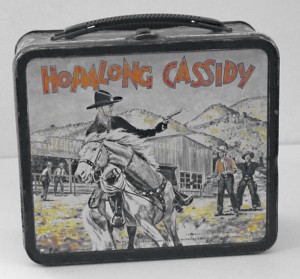The America of the 1800s was a time of growth and development of the country’s infrastructure. Building railroads and roadways, clearing forests, working the mines and manning the factories required an immense amount of manpower, and when lunchtime came . . . they all had to be fed. Out of necessity came the lunch box.
The earliest boxes were no more than repurposed biscuit, tea and tobacco tins. The first commercially produced boxes appeared in 1902 and were not actually boxes but small two-handled woven baskets. The thermos, which had been invented in 1892, was perfected by 1904 and became the natural companion for the lunch box. Together they were sold as a “lunch kit.”
Through the first half of the 20th Century the common lunch box served the working class well. Yet, Aladdin and other major manufacturers found themselves in a dilemma. While the lunch box was a necessity and initial sales were strong, there was very little repeat business. Made of metal, the boxes were highly durable and once you had one, there was seldom the occasion to buy another.
In an effort to boost their sales Aladdin hired a top industrial designer to assist them in producing a line of lunch boxes that would be purchased not out of need, but from the desire to keep up with changing styles. Targeting the school children of America, they released their Hopalong Cassidy lunch box with a decal of the TV cowboy in 1950. Sales soared and in 1952 they followed Hoppy with their now classic Tom Corbin, Space Cadet. Both of these boxes are a must-have for any serious collector. But be warned, their originally price tag of $2.39 has been replaced with a purchase price of in excess of $200.
In 1953, American Thermos of Connecticut released the first Roy Rogers and Dale Evans lunch boxes. In contrast to the one decal design from Aladdin, American offered full color lithography on all sides. The result was a record-setting $2.5 million in sales the first year. Aladdin followed suit with full box lithography in 1954, as did ADCO, Liberty, Universal and Ohio Art. By the end of the 1950s, over 100 manufacturers had entered the race to be the first to garner the rights to the top children’s programming of the day.
Buying the licensing rights to the popular children’s TV shows was an expensive endeavor, which often backfired as the shows were cancelled before the product could hit the shelves. Aladdin found a solution to this problem in 1957 with the release of generic theme domed lunch boxes. These boxes, who’s shape mimicked the workingman’s lunch pail, are highly sought by collectors for their top quality art work. Of particular interest are the Buccaneer, the Volkswagen Bus and the Disney School Bus.
In 1972 federal legislation deemed the metal lunch box unsafe and for a short time it was replaced by the vinyl lunch box. These boxes were really no more than a flimsy cardboard frame covered with shower curtain fabric, and few have survived. Their rarity makes them collectible with the highest valued boxes being Barbie, the Beatles, and the Bobby Soxer.
So why the growing interest in lunch boxes as a collectible? It may be their nostalgic appeal, as they remind us of the TV heroes of our childhood. I am certain for some it is an appreciation for the artistry of mid-20th Century tin lithograph. But for me, they evoke the memory of watching the clock on the school room wall in anticipation of the lunch hour. No time since has a peanut butter and jelly sandwich tasted so good. Until next time . . . Linda
Linda Kennett is a professional liquidation consultant specializing in down-sizing for seniors and the liquidation of estates and may be reached at 317-258-7835 or lkennett@indy.rr.com



